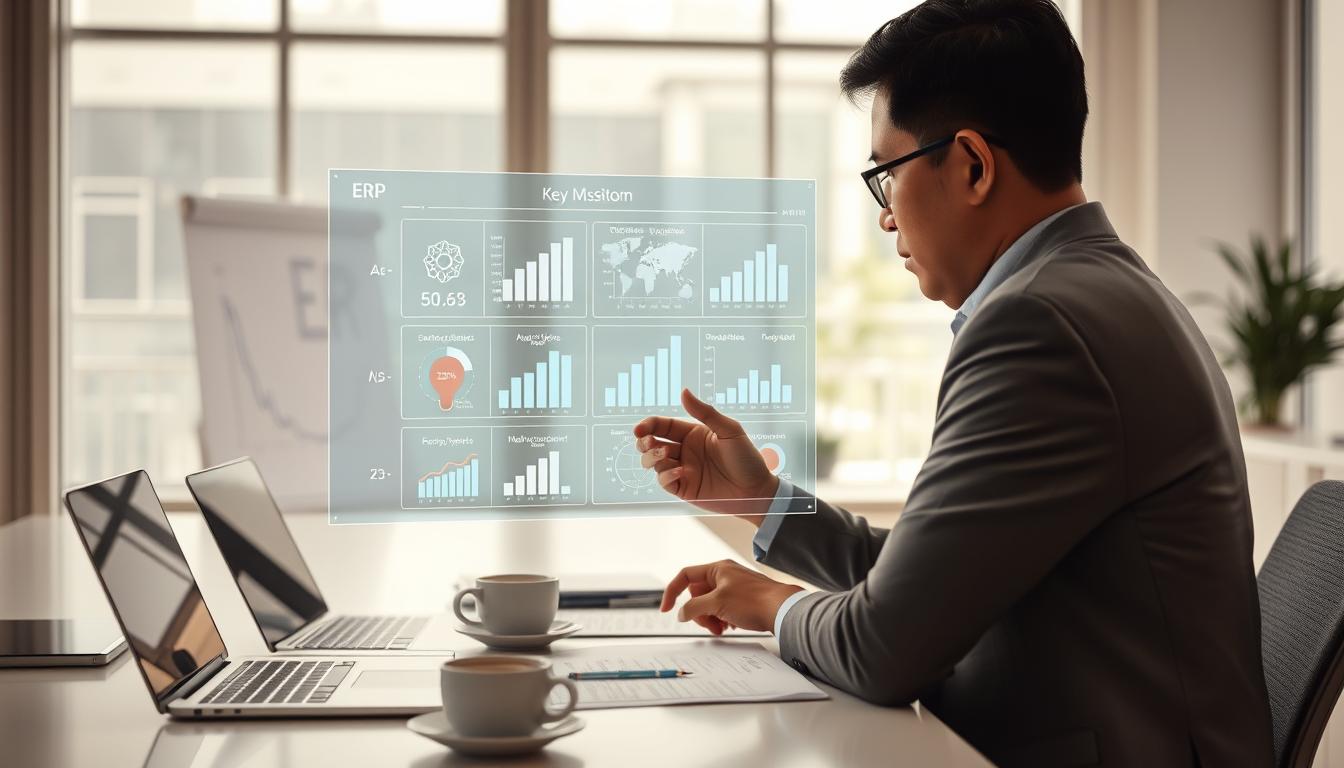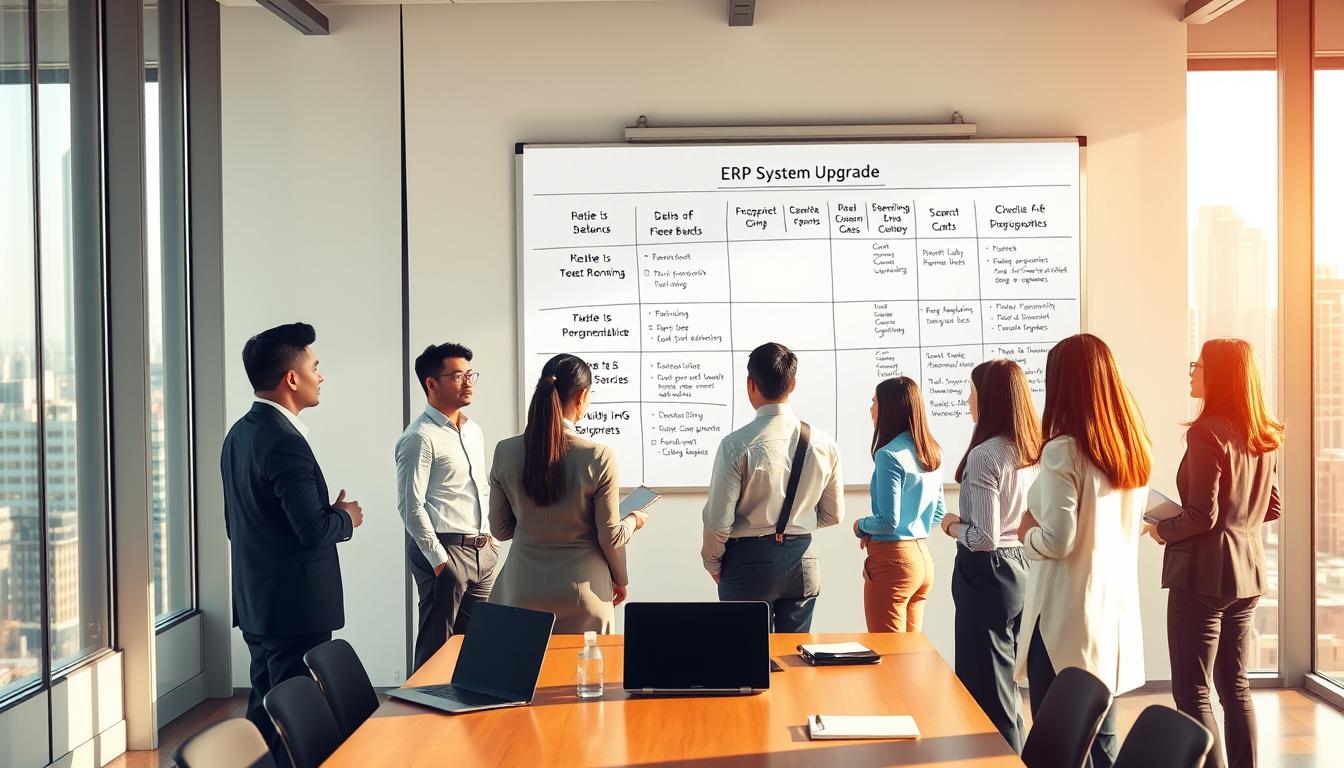Is your business ready for ERP upgrades, or could it face chaos? Upgrading an ERP system might seem daunting, but it’s a big chance. It can make your operations smoother and more efficient, keeping your business running without a hitch. This article will show you how to handle ERP upgrades smoothly, reducing disruptions and boosting your business.
Key Takeaways
- ERP upgrades are essential for maintaining business competitiveness.
- Proper planning minimizes system disruptions during upgrades.
- Engaging your team can enhance the upgrade process.
- Prioritizing high-impact areas ensures effective use of resources.
- Testing and validation are crucial to success.
- Post-implementation support is vital for continuous improvement.
Understanding the Importance of ERP Upgrades
Upgrading your ERP system is essential today. As markets change, so do the tech solutions needed. Modern systems offer better functionality, boosting performance in all areas. In the Philippines, outdated systems can hold businesses back.
Why Modernization is Key for Businesses
ERP modernization keeps companies competitive. Old tech can slow things down, hurting productivity. Upgrades bring in new innovations, making operations smoother and customer service better. The need for quick data and smooth integration makes upgrades vital.
Benefits of Upgrading Your ERP System
ERP upgrades offer many benefits. Companies see:
- Access to modern tools that make workflows better.
- Improved integrations with other key software.
- Lower costs thanks to better efficiency.
- Happier employees from easier-to-use systems.
These changes help businesses perform better. A strong ERP system helps make faster decisions and run smoother operations. This lets companies adapt quickly to market changes.
| Benefit | Description |
|---|---|
| Access to Modern Tools | Using the latest tech to boost efficiency. |
| Better Integrations | Connecting with other systems for a smooth workflow. |
| Reduced Operational Costs | Removing waste saves money. |
| Improved User Experiences | Easy-to-use systems boost motivation and productivity. |
In summary, keeping up with ERP upgrades and modernization is key for growth and success in a competitive market.
Assessing Your Current ERP System
Doing a deep dive into your current ERP system is key to finding ways to improve. It helps spot areas where things aren’t working well and where things slow down. Knowing these problems helps make sure upgrades meet real user needs.
Identifying Pain Points
Finding the pain points in your system is crucial for making it better. Issues like slow reports, hard manual workarounds, or bad data mixing are common. These problems slow things down, so it’s important to know where to focus.
Gathering User Feedback Across Departments
Getting feedback from all departments gives you a clear picture of daily struggles. Talking to people in different areas of the company helps find specific problems. This way, you can choose upgrades that will really help productivity.
Building a Project Team for the Upgrade
Creating a strong project team is key for a successful ERP upgrade. This team should have people from different areas like finance, IT, and operations. Having a team with diverse skills helps solve problems better.
Roles and Responsibilities of Team Members
Each team member has their own strengths. Knowing their roles helps them work better together. Some common roles include:
- Project Manager: Manages the project’s timeline and resources.
- Business Analyst: Collects needs and looks at business processes.
- IT Specialist: Deals with technical parts and system setup.
- Finance Representative: Checks financial rules and handles budget.
Importance of Engaging Stakeholders
Getting stakeholders involved is crucial for a smooth upgrade. Early involvement helps spot risks and challenges. This openness can make everyone more accepting of the change.
| Role | Responsibilities | Stakeholder Interaction |
|---|---|---|
| Project Manager | Manage timelines, oversee team performance | Regular updates with senior management |
| Business Analyst | Document requirements, analyze processes | Collaboration with various departments |
| IT Specialist | Handle integrations, maintain system health | Coordinate with IT leadership |
| Finance Representative | Monitor budget, ensure compliance | Engage with financial stakeholders |
With a solid project team and good stakeholder involvement, ERP upgrades can succeed. The team’s work, along with clear roles and stakeholder support, helps reach the project’s goals.
Defining Scope and Priorities
Understanding the project scope is key when managing an ERP upgrade. A clear outline helps navigate the complexities of implementation. It ensures critical functions keep running smoothly. By setting goals and prioritizing, businesses can streamline processes and tackle their most urgent needs.
Setting Realistic Goals for the Upgrade
Setting achievable goals helps teams stay focused. Here are some tips for setting goals:
- Align goals with overall business objectives to foster unity.
- Use quantifiable metrics to measure progress and success.
- Adjust goals based on feedback and ongoing assessments of project scope.
Focusing on High-Impact Areas First
Prioritization is crucial during the upgrade process. Identifying and targeting high-impact areas can lead to significant improvements. Here’s a comparison of focusing on different areas:
| Area of Focus | Impact Level | Resource Allocation |
|---|---|---|
| Core Financial Functions | High | 40% |
| Reporting and Analytics | Medium | 30% |
| User Interface Enhancements | Low | 15% |
| Optional Features | Very Low | 15% |
This approach helps manage the project scope effectively. It keeps the upgrade process resilient and efficient.
Evaluating Customisations and Integrations
When upgrading an ERP system, it’s key to look at custom features and integrations. This step helps keep important functions while avoiding problems. It lets businesses streamline their systems for better efficiency.
Assessing Existing Custom Features
Companies add custom features for their unique needs. Checking these features is important to see which ones are still useful. This makes the system work better and keeps users happy.
Understanding Dependencies with Other Systems
Knowing how systems work together is crucial for a smooth ERP upgrade. A detailed look at these interactions helps find ways to handle risks. This ensures all systems work well together, keeping the business running smoothly.
Planning Data Migration
Getting data migration right is key for a smooth ERP upgrade. Good planning helps avoid problems and keeps important data safe. Cleaning up data and testing it securely are crucial steps. These steps help organizations move data smoothly and efficiently.
Strategies for Data Cleanup Prior to Migration
Cleaning up data is the first step in a successful migration. Before starting, several steps are needed to ensure data quality:
- Remove Duplicates: Find and remove duplicate records to keep data clean.
- Validate Data Integrity: Make sure all data is correct and consistent.
- Ensure Data Relevance: Decide which data is important and get rid of the rest.
Testing Data Migration in a Secure Environment
Secure testing is vital before moving data. It finds problems without affecting work. Here are some good ways to test:
- Simulated Migrations: Test migrations to see if they work as planned.
- Engagement of Data Experts: Work with experts to make data mapping better and faster.
- Feedback Mechanisms: Use feedback to improve the migration process.
By cleaning up data well and testing securely, companies can handle data migration confidently. These steps protect important data and make the transition smoother.
| Cleanup Strategy | Description | Benefits |
|---|---|---|
| Remove Duplicates | Eliminating duplicate entries from the database. | Improves data accuracy and saves storage space. |
| Validate Data Integrity | Checking that all data is consistent and accurate. | Reduces errors during migration and enhances reliability. |
| Ensure Data Relevance | Identifying essential data for the migration process. | Streamlines migration by focusing only on necessary information. |
Testing and Validation Processes
Testing and validation are key steps in upgrading an ERP system. They make sure everything works right, reducing the chance of unexpected problems. By testing thoroughly, teams can find and fix issues early, making the upgrade smooth.
Importance of Thorough Testing
Testing each part of the ERP system is crucial for a successful upgrade. It checks how users interact with the system and how it handles data. This ensures the system is reliable and meets all requirements.
Simulating Real-World Scenarios for Risk Mitigation
Testing the ERP system in real-life scenarios helps predict how it will work. This approach finds hidden problems and lets teams fix them before the system goes live. It makes the system more stable and reduces risks.
Training Your Team Effectively
Getting an upgraded ERP system to work well depends on good employee training. A solid training plan helps your team use the new system smoothly. It’s key to plan early and make sure training covers the system’s new features and why they’re important.
Developing Training Programs
Creating effective training programs means thinking about what your employees need. Custom training sessions can really help. Using different learning tools like videos, guides, and interactive modules helps everyone learn in their own way.
This way, everyone can learn the skills needed to use the new ERP system well.
Utilizing Hands-On Sessions for Better Understanding
Hands-on learning is great for training. It lets team members try out the system themselves. Practical exercises help them learn by doing, in a safe space.
This method boosts confidence and makes change easier. Giving users lots of chances to try out new features helps them adjust better.
| Training Method | Description | Benefits |
|---|---|---|
| Workshops | Interactive sessions where employees can ask questions and learn collaboratively. | Encourages team bonding and enhances understanding through discussion. |
| Online Modules | Self-paced learning where employees can access materials anytime. | Flexibility to learn at one’s convenience, accommodating various schedules. |
| Simulation Exercises | Practical scenarios that mimic real-life operations in the new system. | Real-world application of skills, aiding retention of information. |
Good employee training is key to getting the most out of a new system. Using hands-on learning helps create a culture that values growth and change.
Post-Implementation Support
After a new ERP system is live, strong support is key. A dedicated team is needed to handle any immediate issues. This helps keep operations running smoothly and quality high.
Strategies for Continuous Support After Go-Live
For ongoing improvement, regular check-ins and troubleshooting are crucial. This way, teams can fix problems fast. Also, having a detailed knowledge base helps users solve issues on their own.
Importance of Feedback in Post-Implementation Optimization
User feedback is essential for improving ERP systems. It helps make processes better and boosts system performance. By listening to employees, companies can adapt quickly and meet changing needs.
By focusing on user feedback, businesses can improve continuously. This leads to higher satisfaction and productivity.
Choosing the Right Go-Live Window
Picking the right time for your ERP upgrade is key. The timing can greatly affect how smooth the transition is. A good plan helps keep everyone focused and ready for any problems.
Avoiding Busy Periods to Minimise Disruption
Upgrading during quiet times is important for keeping things running smoothly. A well-thought-out schedule helps avoid busy hours. This lets the team focus on watching the transition closely.
Here are some tips for choosing the best time:
- Look at past data to find quieter times.
- Work with department heads to see when they’re busiest.
- Check your calendar for holidays or slow times.
Preparing for Immediate Issue Resolution
Having a plan for fixing problems right away is crucial. Knowing what might go wrong and having solutions ready helps fix issues fast. Preparation includes:
- Setting up a team to handle problems.
- Having plans for expected issues.
- Teaching users how to report problems.
With a solid plan, businesses can handle upgrades smoothly and with less trouble.
Conclusion
Managing ERP system upgrades well is key for businesses today. A structured approach helps ensure upgrades boost efficiency without major hiccups. This way, companies can keep their operations running smoothly.
It’s important to involve employees in the upgrade process. Good communication and training help them adjust to new systems. This reduces resistance to change. Also, staying open to improvement and change makes future upgrades easier.
For small and medium businesses in the Philippines, a clear strategy for ERP upgrades is crucial. It helps them stay competitive and grow sustainably. This approach ensures they can adapt to changing markets and technology.
FAQ
Why are ERP upgrades important for SMEs in the Philippines?
ERP upgrades are key for SMEs in the Philippines. They modernize operations and boost efficiency. This ensures business continuity and keeps them competitive.
How can businesses assess their current ERP systems?
Businesses should first identify what’s slowing them down. They can gather feedback from various departments. This helps spot issues like slow reporting and poor data integration.
What should businesses include in their project team for an ERP upgrade?
A good project team includes finance, IT, and operations stakeholders. Having a project manager and clear roles boosts accountability and teamwork.
How can I define the scope of the ERP upgrade effectively?
Defining the scope means setting realistic goals and focusing on key areas. Prioritizing essential upgrades reduces risks and keeps critical functions running.
What strategies can aid in smooth data migration?
Smooth data migration starts with a thorough cleanup. Remove duplicates, check data integrity, and make sure it’s relevant. Testing in a safe environment also helps find issues before they go live.
How crucial is testing during the ERP upgrade process?
Testing is vital to ensure the system works as expected. It helps catch problems early and makes sure the system is ready for use.
What training methods should be employed for staff on the new ERP system?
Training should start early and be hands-on. Include practical exercises and easy-to-use materials. This builds confidence and helps staff adjust to the new system.
Why is post-implementation support necessary?
Post-implementation support is crucial for solving any issues that come up. A responsive team and ongoing feedback improve both processes and software performance.
How can businesses choose the right go-live window?
Choose a quiet time for the go-live to cause less disruption. Also, have plans ready for any unexpected problems that might arise.



